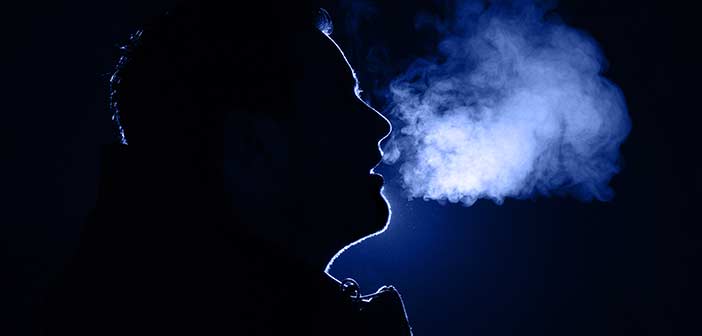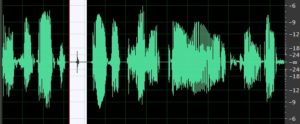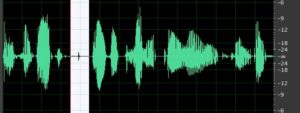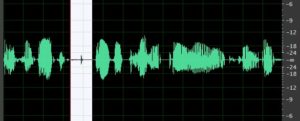
This blog aims to tackle the misconceptions in the voice-over world relating to when you should, and just as importantly when you should not debreath your voice-over recordings. It’s not done correctly that often, but it’s easy to do (in the right place) when you know how.
Firstly, let’s start at the beginning of this topic and answer the question:
What is Debreathing?
Debreathing is where you take a recorded voice performance, you select the breath and you remove it. Here’s a clip recorded in Adobe Audition where you can see the breath highlighted:
and rather predictably, here’s the same clip, but with the breath removed:
Notice here that the breath has actually been silenced rather than deleted. This is an important distinction to note when discussing debreathing audio. If we had actually deleted the breath and it’s space rather than just silenced it, it would look like this:
Which is a different thing. The first has silenced the breath and the second has removed it and the time taken to do it entirely.
So When and Why Would You Debreath a Voice-Over Recording?
Traditionally, one would debreath commercial voice-overs. There are a couple of valid reasons for doing this:
- The advertiser does not want the listener’s focus to be removed in any way from the message, which is the product or service that is being advertised. Even on a subconscious level, having breath in the performances brings the listener back to the fact that this is a human being delivering the message.
- Commercials, especially ones with visuals, are often highly stylised beasts, with varying tempo’s and prosody patterns. In this case the message is not about the voice-over artist but purely the message. Varying the pace or the prosody pattern often increases the number of breaths or their emphasis, and again, this is irrelevant to the message, and often distracting.
- Many commercial voice-overs are purposefully close-miked to get that lovely bass-proximity effect In this case, once the voice-over is properly treated, the breath’s will be much louder proportionally than they would be in real life. This is therefore, a distraction to the message.
- Once voice-over clips are post-produced, i.e., compressed, and then their volume brought up appropriately (through mixing or normalisation) the breath-volume-level is artificially increased. This is a distraction to the message.
Commercial voice-overs need to focus purely on the message, and without distraction, which includes the breath
So what’s the problem? Why isn’t it just that simple, i.e., debreath commercial voice-over and nothing else?
The Problem with Debreathing Commercial Voice-Over
The problem with debreathing commercial voice-over lies in the definition of what commercial voice-over is. Commercial voice-over could be taken as one of two things by the definition of the word. Firstly, it could be taken as voice-over which is used by a company, and which you are paid for, which is therefore, commercial in its nature. Secondly, it could be taken as actual advertisements, either on television, radio, cinema, or web adverts, and therefore commercial in its nature.
Many voice-over artists will debreath both versions of commercial work. Unless we’re specifically asked, we should only debreath the second version… or actual advertisements. Remember, we’re only debreathing so that the message of an advertisement is not distracted in any way.
Why Should We Not Debreath Any Other Types of Voice-Over?
There are a few reasons for not debreathing the first definition of voiceover, corporate work, gaming performances, narrative VO, dramatic VO, Voice of God…and so on.
Firstly, we are all human beings and we are used to hearing people breath when they talk – it’s just part of our natural conversation. If it’s not there, we miss it. Generally with commercial audio (adverts), there is a lot of music in the background, and sometimes effects as well, so we tend not to notice that the breaths aren’t there when we hear them. But if you hear a person talking on their own, and remove all the breathing, it becomes uncomfortable to listen to. We tend to feel unconsciously stressed-out while we’re waiting for this superhuman-lunged person to actually take a breath!
Historically, the best text-to-speech services like Eleven Labs, Siri, or the Google voice. Great though they were…didn’t have audible breathing. In more recent years these have been updated to include breathing as the breath is a part of the human condition, and recordings sound less-human without it…
Secondly, breathing gives a natural pause for the listener to assimilate what has been communicated to them. It allows time for thought processes to happen, and internal decisions to be made. All-too-often, I hear non-advertisement dialogue that has been debreathed and all the space removed. It happens in an awful lot of American radio commercials – the issue is that the audience walks away from the voice-over not really remembering any of it.
Lastly, as the voice-over artist, breathing denotes a natural style of delivery. Natural delivery in voice-over is the current trend and what everyone wants. If you remove the breathing from the performance, by default you remove an element of its naturalness and turn it into something less than it is.
Breathing indicates a natural style of delivery. Remove the breaths and you remove all sense of the naturalness of the piece, and make it less than it is.
Accidentally Removing Breaths in Vocal Recordings
As a last word on the subject, it’s worth pointing out that if you use tools like noise gates or expanders you will be inadvertently removing the breathing as well as the noisy environment. Usually this is in an attempt to clean up the sound of a poor recording environment. This has all the same consequences as removing the breathing in the first place.
Your recording environment may sound better, but you’ve just killed the human element to your performance.
Fix your recording environment, don’t fudge it with noise gates and expanders! That’s the way of the amateur!
In Conclusion
Don’t debreath your voice recordings unless they are specifically for commercial advertising. Even then, make sure you check with your employer, client, or hirer as to whether you actually should.
Your breath is part of the human condition – we need it, we expect it. In an age where we as humans are competing with AI vocals, it’s important that we recognise our humanity and platy to our advantages – leave in your breaths unless you are asked to remove them.
However, if you’re specifically asked to debreath voice-over in other parts of the industry, corporate etc, then ignore this article entirely. Do as you’re told! They pay the fee, after all!
[Updated 2024]



Leave a Reply
You must be logged in to post a comment.